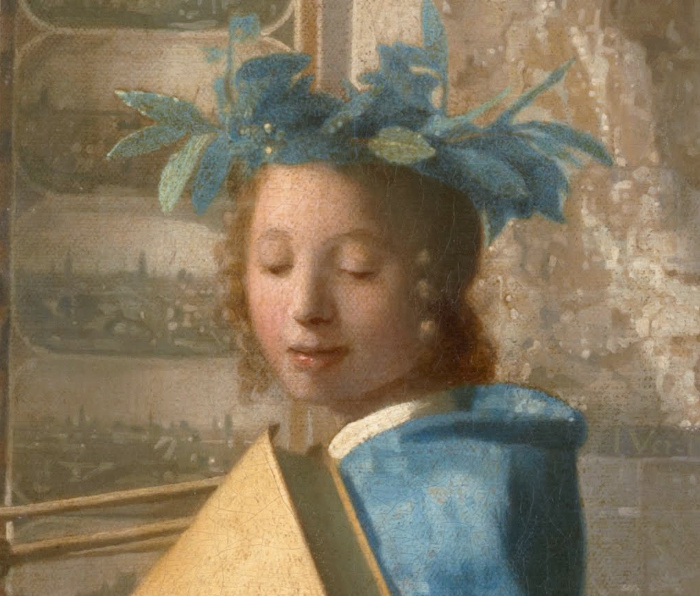Glazing
A curious aspect in The Art of Painting is the unnatural blue cast of the laurel wreath worn by the young model, Clio, the muse of history. This effect is also observed in the foliage of The Little Street. In both pictures, it is probable that Vermeer used a well-known technique called "glazing" to to achieve a specific shade of green which in time has altered.While layering was common, direct mixing of pigments was also used. Painters mixed blue and yellow pigments to achieve various green shades on their palettes before applying them to the canvas. The most common blue pigments mixed were azurite and smalt, while yellows included lead-tin yellow, massicot, or yellow ochre.

Johannes Vermeer
c. 1662–1668
Oil on canvas, 120 x 100 cm.
Kunsthistorisches Museum, Vienna
Vermeer initially modeled the leaves in various shades of blue and allowed them to dry thoroughly. He then applied a very transparent layer of paint, known as a glaze, over the blue leaves. The two colors, blue and yellow, combined together optically but not physically, resulting in a deep, natural green unattainable with any single green pigment available to artists at the time. The overlying yellow lake—a fugitive pigment likely made from weld (known in Dutch as "wouw" or "woude")—is a natural dyestuff obtained from the cultivated plant Dyer's Rocket, a tall-growing relative of the garden mignonette. This pigment has faded with time, exposing the blue of Vermeer's underpainting, or it may simply have been removed in past restoration attempts. The same phenomena can be observed in the vegetation of Vermeer's Little Street.

This jewel-like effect, which is analogous to the effect produced by stained glass, cannot be achieved by direct painting with opaque paint. Artists also employed glazing to create the so-called "strong colors" unavailable as single pigments. For instance, to create purple, applying a glaze of the prized natural ultramarine blue over a reddish underpainting or by applying red madder over a bluish underpainting (such as azurite) was necessary. The end result of glazing is very difficult to anticipate, and its significance is perhaps overestimated by art historians, as they may attribute any subtleties to the use of glazing.
In any case, a broad range of blue pigments mixed with yellows: the making of green was complex allowed artists to explore many combinations of pigments to achieve the hues of green they desired for the broad spectrum of green tonalities in nature.Jørgen Wadum, "Perceiving Green – Red, Yellow, and Blue: The Making and Colour Change of Paintings by Van Schrieck and Weie," Perspective (2019), accessed November 9, 2023.